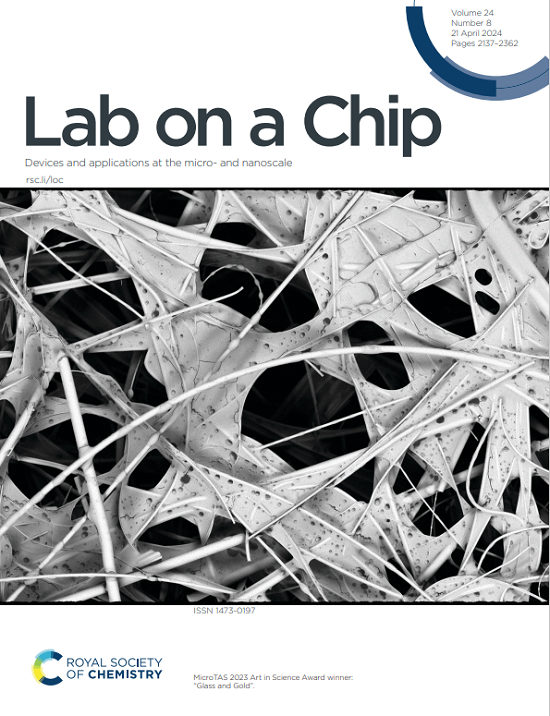基于电阻抗断层成像(EIT)的细胞内电导率成像无创细胞检测
IF 5.4
2区 工程技术
Q1 BIOCHEMICAL RESEARCH METHODS
引用次数: 0
摘要
基于电阻抗断层成像(EIT)的细胞内电导率成像是一种新的非侵入性技术,用于在单细胞尺度上绘制活细胞的电学特性。为了实现这一目标,开发了一种微型EIT系统,该系统集成了两个主要组件:定制设计的微型EIT传感器和频率差分EIT以及基于单细胞等效电路的重构算法。该微型eit传感器设计用于匹配单细胞规模,并通过电子束光刻技术在玻璃基板上制造,具有高空间分辨率(7 μm电极宽度,40 μm间距),稳定的频率响应,信噪比通常在50到200之间。频差EIT基于单细胞等效电路模型,通过电流响应分析,实现了细胞质σcyt和核质σnuc电导率分布的重构。为评价其性能,采用阻抗谱法重建三种不同蛋白表达的人肺成纤维细胞系(MRC-5)的细胞内电导率图像。结果,成功重构了三种细胞类型的σcyt和σnuc,结果显示出与蛋白表达变化相对应的明显差异。同时进行了明场和荧光观察,验证了EIT结果,证明了细胞质和核质坐标和大小的可靠性。这项工作代表了基于电学性质区分亚细胞结构的非侵入性细胞内电导率映射的首次演示。本文章由计算机程序翻译,如有差异,请以英文原文为准。
Electrical Impedance Tomography (EIT)-Based Intracellular Conductivity Imaging for Non-invasive Cell Detection
Electrical impedance tomography (EIT)-based intracellular conductivity imaging is newly proposed as a non-invasive technique for mapping the electrical properties of living cells at the single-cell scale. In order to achieve this, a micro-EIT system is developed, which integrates two main components: a custom-designed micro-EIT sensor and a frequency-differential EIT coupled with a single-cell equivalent circuit-based reconstruction algorithm. The micro-EIT sensor is designed to match single-cell scale and fabricated on a glass substrate by electron beam lithography, which enables high spatial resolution (7 μm electrode width, 40 μm spacing), stable frequency response, and signal-to-noise ratios typically ranging from 50 to 200. The frequency-difference EIT achieves the reconstruction of conductivity distributions of the cytoplasm σcyt and nucleoplasm σnuc through current response analysis based on the equivalent circuit model of single-cell. To evaluate the performance, impedance spectra were measured to reconstruct the intracellular conductivity images in three types of Medical Research Council 5 human lung fibroblast cell lines (MRC-5) with different protein expressions. As a result, σcyt and σnuc of three cell types were successfully reconstructed, which revealed clear differences corresponding to variations in protein expression. The brightfield and fluorescence observation were also performed to verify the EIT results, which demonstrated the reliability of the coordinates and size of the cytoplasm and nucleoplasm. This work represents the first demonstration of non-invasive intracellular conductivity mapping that distinguishes subcellular structures based on electrical properties.
求助全文
通过发布文献求助,成功后即可免费获取论文全文。
去求助
来源期刊

Lab on a Chip
工程技术-化学综合
CiteScore
11.10
自引率
8.20%
发文量
434
审稿时长
2.6 months
期刊介绍:
Lab on a Chip is the premiere journal that publishes cutting-edge research in the field of miniaturization. By their very nature, microfluidic/nanofluidic/miniaturized systems are at the intersection of disciplines, spanning fundamental research to high-end application, which is reflected by the broad readership of the journal. Lab on a Chip publishes two types of papers on original research: full-length research papers and communications. Papers should demonstrate innovations, which can come from technical advancements or applications addressing pressing needs in globally important areas. The journal also publishes Comments, Reviews, and Perspectives.
 求助内容:
求助内容: 应助结果提醒方式:
应助结果提醒方式:


